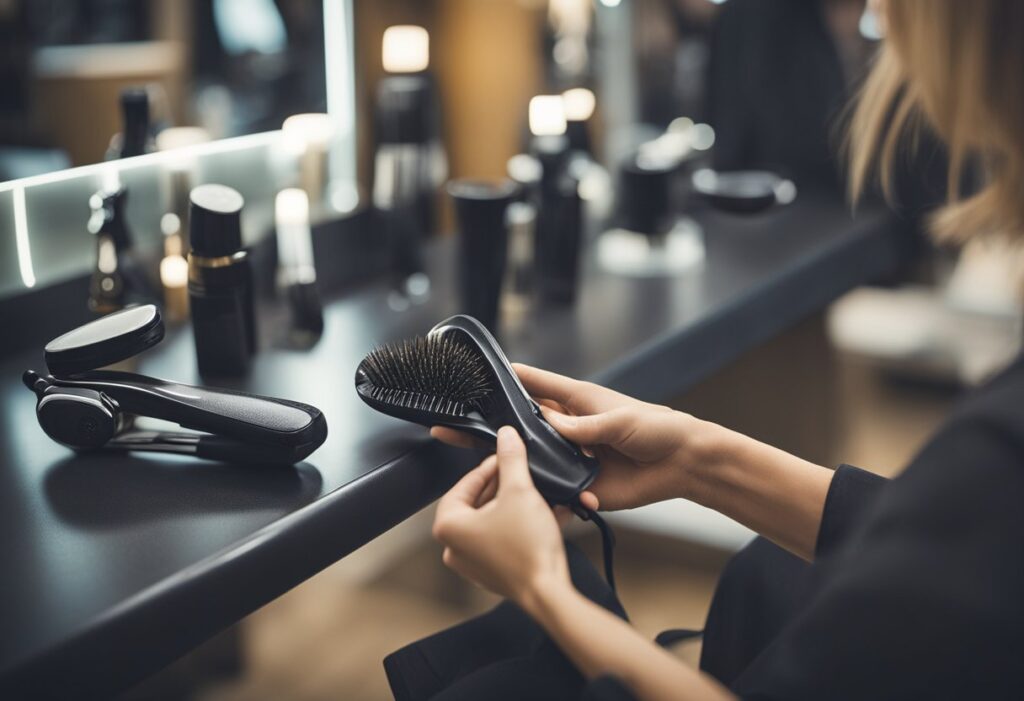Are you a mobile hairdresser struggling to set your prices? It can be challenging to determine the right amount to charge for your services, especially if you are just starting. Setting your prices too low can lead to a lack of respect from clients and make it difficult to earn a living. On the other hand, setting your prices too high can make it challenging to attract new clients.

To avoid these pitfalls, it’s essential to do your research and find out what other self-employed hairdressers are charging in your area. For example, outside of London, you would find hairdressers charge around £20 to £25 for a basic cut and style. If you’re working in London, the prices people expect to pay would be slightly higher. You can choose two options when setting your prices. You can either match the prices of other hairdressers in your area or charge slightly less to attract new clients.
Another factor to consider when setting your prices is the type of clients you want to attract. If you are targeting high-end clients, you may need to charge more for your services. However, if you want to attract budget-conscious clients, you may need to set your prices lower. Keep in mind that it’s essential to find the right balance between charging enough to make a living and being competitive in your market.
Getting Started
Becoming a self-employed mobile hairdresser can be an exciting and rewarding career choice. Not only do you get to be your own boss, but you also have the flexibility to set your own schedule and work from the comfort of your own RV or home. However, before you start, there are a few things you need to consider.
Firstly, you need to have the necessary training and qualifications to become a mobile hairdresser. This may include obtaining a NVQ or City & Guilds qualification in hairdressing. You can also consider taking additional courses to improve your skills, such as colouring or cutting techniques.
Once you have the necessary training and qualifications, you need to decide on your pricing strategy. Consider your experience and the quality of your work when setting your prices. It’s important to charge what you’re worth, but also be mindful of what your competitors are charging in the area.
Being self-employed also means that you need to take care of your own insurance and registration. This includes public liability insurance, which will protect you in case of any accidents or injuries to your clients. You may also need to register your business with the relevant authorities, such as HMRC.
Overall, becoming a self-employed mobile hairdresser requires a lot of hard work and dedication. However, with the right training, qualifications, and pricing strategy, you can build a successful business that offers flexibility and freedom.
Building Your Mobile Hairdressing Business
Starting and growing your mobile hairdressing business requires effective marketing strategies and a strong online presence. Here are some key steps to help you establish and expand your business:
1. Create a Professional Brand
Develop a unique and professional brand identity that reflects your style and expertise. This includes designing a logo, choosing a colour scheme, and creating a consistent visual identity across all your marketing materials.
2. Utilize Social Media
Harness the power of social media platforms like Facebook to reach a wider audience. Create a dedicated Facebook page for your mobile hairdressing business and regularly post engaging content, including before and after photos of your clients, hair care tips, and promotions. Engage with your followers by responding to comments and messages promptly.
3. Invest in Business Cards
Business cards are an essential tool for networking and promoting your services. Design eye-catching business cards that include your contact information, services offered, and a brief description of your expertise. Distribute them to local businesses, community notice boards, and potential clients.
4. Build a Professional Website
Having a well-designed website is crucial for establishing credibility and attracting new clients. Include detailed information about your services, pricing, and contact details. Showcase your portfolio of work and include testimonials from satisfied clients. Ensure your website is mobile-friendly for easy browsing on smartphones and tablets.
5. Distribute Flyers and Leaflets
Create attractive flyers and leaflets advertising your mobile hairdressing services. Distribute them in local neighbourhoods, community centres, and hair salons. Highlight your unique selling points, such as flexible appointment times and personalized services.
6. Start a Newsletter
A regular newsletter can help you stay connected with your existing clients and attract new ones. Use email marketing platforms to send out newsletters with updates on your services, special promotions, and hair care tips. Encourage clients to subscribe to your newsletter through your website or social media channels.
7. Explore Hairdressing Apps
Consider using mobile apps specifically designed for hairdressers to streamline your business operations. These apps can help you manage appointments, track client information, and handle payments efficiently. Look for apps that offer features like online booking, automatic reminders, and inventory management.
Remember, building a successful mobile hairdressing business takes time and effort. Stay consistent with your marketing efforts, deliver exceptional service, and continuously seek feedback to improve your skills and grow your client base.
Key Equipment and Tools

As a mobile hairdresser, it’s essential to have the right equipment and tools to provide quality services to your clients. Here are some of the key equipment and tools you’ll need to get started:
Chair
A comfortable and sturdy chair is a must-have for any mobile hairdresser. Look for a lightweight and foldable chair that is easy to transport and set up. A chair with an adjustable height will allow you to work at the right level for your client, reducing strain on your back and arms.
Combs, Scissors, and Razors
Invest in high-quality combs, scissors, and razors to ensure that you can provide precise and professional haircuts. Stainless steel blades are durable and easy to clean, while ergonomic handles will reduce hand fatigue during long styling sessions.
Washbasin
A portable washbasin is an essential piece of equipment for any mobile hairdresser. Look for a lightweight and easy-to-clean basin that can be filled with water and shampoo. A washbasin with a built-in drain will make it easy to dispose of the used water.
Mirrors
Having a good-quality mirror is essential for showing your clients their new hairstyle from different angles. A lightweight and shatterproof mirror that can be easily attached to your work area is ideal for mobile hairdressing.
Blow Dryers and Hair Dryers
A high-quality blow dryer and hair dryer are essential tools for any mobile hairdresser. Look for a lightweight and powerful dryer with multiple heat and speed settings to cater to different hair types. A hair dryer with a long cord will give you more flexibility when styling hair.
Straighteners
Hair straighteners are essential for creating sleek and smooth hairstyles. Look for a lightweight and portable straightener with ceramic plates for even heat distribution. A straightener with adjustable temperature settings will allow you to cater to different hair types.
In conclusion, having the right equipment and tools is crucial for any mobile hairdresser. Invest in high-quality and portable equipment that is easy to transport and set up, and you’ll be well on your way to providing quality services to your clients.
Setting Your Prices
As a mobile hairdresser, setting the right prices for your services is crucial to the success of your business. Here are some tips to help you determine the right prices for your services.
Understanding Costs
To set your prices, you need to understand your costs. This includes the cost of your supplies, equipment, travel expenses, insurance, taxes, and any other overheads. Once you have a clear understanding of your costs, you can determine how much profit you need to make to cover your expenses and make a reasonable income.
Research and Competition
Research your local market and competitors to help you set competitive prices. Look at the prices charged by other mobile hairdressers in your area and compare them to the services you offer. Consider offering services at a similar price point to your competitors, or slightly lower if you are just starting out.
Pricing Strategies
There are several pricing strategies you can use to set your prices. Here are some examples:
- Flat rate pricing: This is where you charge a fixed price for a specific service, regardless of the time it takes to complete.
- Hourly pricing: This is where you charge an hourly rate for your services.
- Package pricing: This is where you offer a package of services at a discounted rate.
- Tiered pricing: This is where you offer different levels of service at different price points.
Consider which pricing strategy works best for your business model and customer satisfaction. You may also want to consider offering discounts for repeat customers or referrals.
Remember to keep your price list up to date and review it regularly to ensure that your prices remain competitive and profitable.
By following these tips, you can set the right prices for your mobile hairdressing business and ensure that you are making a profit while keeping your customers happy.
Managing Appointments and Clientele
As a mobile hairdresser, managing your appointments and clientele is crucial to the success of your business. Here are some tips to help you stay on top of things:
1. Book Appointments Efficiently
It’s important to have a system in place for booking appointments. You could use a scheduling app or software to help you keep track of your bookings. Make sure to communicate clearly with your clients about the date, time, and location of the appointment.
2. Be Flexible
Being a mobile hairdresser means that you’ll have to be flexible with your schedule. You may need to work outside of regular business hours to accommodate your clients’ schedules. Make sure to communicate your availability clearly so that your clients know when they can book appointments with you.
3. Build a Strong Clientele
Building a strong clientele is key to the success of your mobile hairdressing business. Make sure to provide excellent service to your clients and listen to their needs and preferences. Word of mouth is a powerful marketing tool, so make sure to ask your clients to refer you to their friends and family.
4. Offer a Variety of Services
Offering a variety of hairdressing services will help you attract a wider range of clients. Consider offering services such as haircuts, hairstyling, hair colouring, highlights, and dye. Make sure to communicate your services clearly on your website and social media pages.
5. Set Your Prices
Setting your prices can be tricky, but it’s important to charge a fair price for your services. Research what other mobile hairdressers in your area are charging and set your prices accordingly. Make sure to communicate your prices clearly to your clients so that there are no surprises.
By following these tips, you can effectively manage your appointments and clientele as a mobile hairdresser.
How to Set Your Prices as a Mobile Hairdresser
Setting your prices as a mobile hairdresser can be tricky, but it’s important to get it right. You want to make sure you’re charging enough to cover your expenses and make a profit, but you also want to be competitive with other hairdressers in your area. Here are some tips for setting your prices:
Research Your Competitors
The first step in setting your prices is to research your competitors. Find out what other mobile hairdressers in your area are charging for the same services. You can do this by searching online or by asking around. Once you have an idea of what others are charging, you can decide whether you want to price your services higher or lower.
Consider Your Expenses
When setting your prices, it’s important to consider your expenses. As a mobile hairdresser, you’ll have expenses such as travel costs, equipment, and product costs. Make sure you factor these expenses into your pricing so that you’re not losing money on each appointment.
Decide on Your Pricing Structure
There are a few different pricing structures you can use as a mobile hairdresser. Here are a few options:
- Flat rate: This is a popular pricing structure because it’s easy for clients to understand. You give a fixed fee before the job starts, and both you and the client know what to expect.
- Hourly rate: You could charge an hourly rate for your services. This can be a good option if you’re doing a variety of services for one client.
- Package pricing: You could offer packages that include multiple services for a discounted price. This can be a good way to encourage clients to book more services with you.
Don’t Undervalue Your Services
It’s important not to undervalue your services. You want to make sure you’re charging enough to cover your expenses and make a profit. Don’t be afraid to charge what you’re worth, even if it’s more than what other mobile hairdressers in your area are charging. Remember, clients are paying for your expertise and convenience.
By following these tips, you can set your prices as a mobile hairdresser in a way that’s fair to you and your clients.




